|
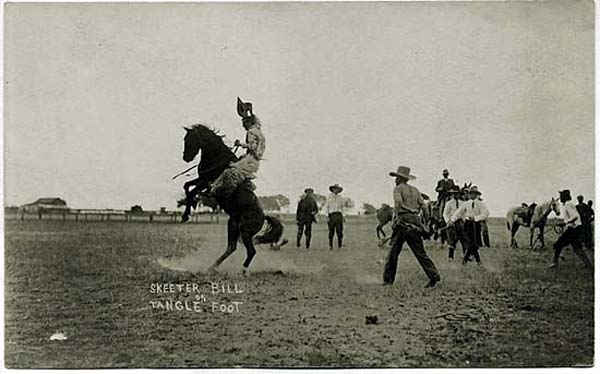
Roy "Skeeter Bill" Robbins on Tanglefoot, 1914. Photo by Joseph Shimitz.
Skeeter Bill placed second in the amateur bucking contest. The photographer, Joseph Shimitz (1873-1929), had a studio on Eddy Street, remamed Carey Street. He advertized that he was the
"official" photographer for Frontier Days. His photographs, some of which are featured relating to Fort
D. A. Russell and others to Frontier Days, are generally from the period 1908 to his death in 1929.
Although Frontier Days has attracted western cowboy movie stars, it has also produced some such as Skeeter Bill (Roy Raymond Robbins (1887-1933)).
Skeeter was a tall, lanky, 6' 5" cowboy from Glenrock. His tall appearance gave rise to his
nickname of "Skeeter."
Within two years of his entry into the amateur bucking contest, Skeeter was recognized as a top cowboy. In 1916, he entered the
1916 New York Stampede. Those two years changed rodeo which morphed from basically an amateur sport to one in which there were professional rodeo cowboys and the shows were put on by
professional rodeo producers. The culimination of the change was at the Boston Garden in 1936 when the Turtle Association was formed. The events at the Boston Garden are discussed on a subsequent page.
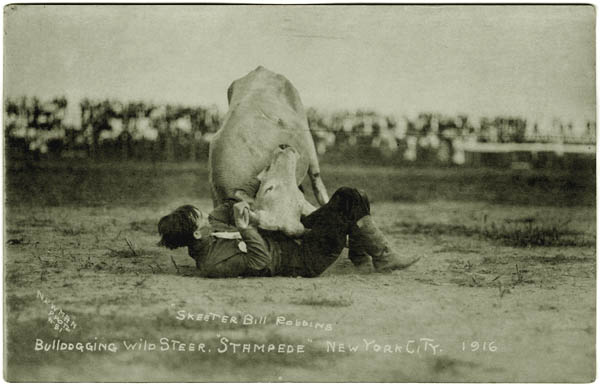
Roy "Skeeter Bill" Robbins Bulldogging at New York Stampede, 1916.
The New York Stampede was produced by Guy weadick, the producer of the Calgary Stampede, it was less than successful.
It was held at the Sheepshead Bay Raceway. It was advertised as a contest in which the champions of all the different rodeos
would compete. Among those attending were Yakima Canutt, Art Acord, Fred Stone, Sam Garett, Chester Byers, Tommy Kirnan, Floyd Irwin, Harry Walters, Leonard
Stroud,Clay McGonigill, Prairie Rose Henderson and Dorothy Morrell. According to what paper you read, opening attendance was 10,000 (New York Times,
24,000 (New York Sun, or 20,000 (Mr. Weadick) It nevertheless failed to meet expenses and some of
the cowboys were left stranded, a topic of conversation as to the unfairmenss of the judging in Rowdy Waddy's column in
Billboard. Mr. Waddy's column, "the Corral," provided a method for rodeo cowboys to keep up with each other and they travelled the circuit. A "waddy" was an itinerent cowboy.
It has been speculated that Rowdy Waddy was Guy Weadicks See LeCompte, Mary Lou, "Cowgirls of the Rodeo, Pioneer Professional lathletes, p. 43. It was also suggested that a
correspondeing column for cowgirls was written by
Mrs. Weakick, Florence Le Due. A typical column from Sept. 22, 1917:
The following has just been received from the Jess Williard-Buffalo Bill Show, signed "The Bundh": "We are having fine weather and big crowds.
Johnny Baker met with an accident in Saginaw, Mich., when his horse slipped and fell with him on the pavement. Mr. Baker was injured pretty badley, but his iron nerve
brought him thru and he is again in the saddle
after spending a couple of days in the hospital. The boys sure showed how much they thought of him when they yellled and cheered when he came into the dressing room
last Tuesday on crutches and took his place directing the performance. There is quite a bit of argument between Tex McLeod and Chester Byers as to sho is the best
roper. Hank Durnell is drawing a good salary, but can't shake loose with enough to buy more than a ten-foot rope at once. Steve Savage sure sets the crowd wild with his
wrestling in the show. Tom Gonzalles narrowly escaped getting hurt the
other night by some one running his bronk into the net. Frank Rose got a big hand when the bronk he was riding ran into the net, tore down the lights and ran into the audience. Frank caught hold of a cable
and hung in the air while the ladies gave him admiring glances.
Buck Moulton is making flying mounts on his bronks. Pete Courtney is going home next Sunday to see if he can get some more good bronks for the show."
Tex Parker writes from San antonio, Tex.: "I joined the army May 24, shortly after the Round-Up at San Antonio and was to be stable sergeant in Troop K, 1st Exas Cavalry, but left to attend the Cowboys'
Reunion at Las Vegas, N. M. When I got back they made me a general--yes. Ad general prisoner--so I was transferred to
Battery D, 2d Texas Field Artillery where I am at present a buck private in the rear ranks.
We expedt to leave for Ft. Worth, Tex., in a few days. The boys and girls at Lakin, Kan., sure gave me a big sendoff the night I left. I was there when I wall called in and the boys gave
me a real celebration. As it was the day before the show and I was broke and had 1,200 miles in fron of me, you can imagine the lump that came up in my throat when the bunch passed the had and got
me a good collection. I just could not express my thanks in mere words. I sure want to hear from all the boys and girls in the game and on the range.
Say, Powder Face, are you a soldier yet? Same to Butch Jones and the rest of the boys at Law Vegas, which, by the way, I consider the best town in the world for a cowboy to have a real time in. I sure would like to hear
from the Allens. By the Way, I would like to say that Cole G. Bailey, the clothing man, located in the Gunter Hotel Building,
is the one man who paid off as he promised at the San Antonio contest. He is a real friend to cowboys, and all you boys look him up when in
San Antonio."
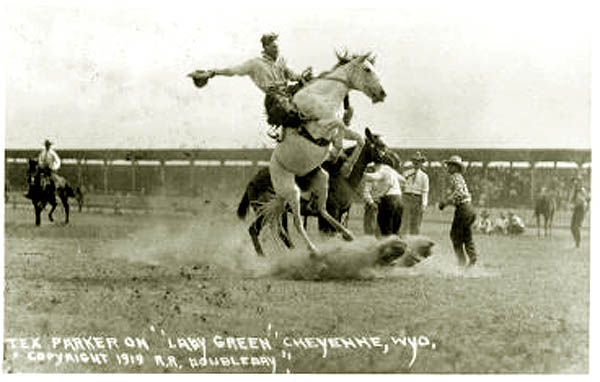
Tex Parker on Lady Green, Frontier Days, 1919. Photo by R. R. Doubleday.
Lady Green was previously owned by Ernie Green who sold the horse to C. B. Irwin in 1916.
In any event, however, Tex Parker did not remain in the army very long. In June 1918, Mr. Waddy reported that Parker was out of the
Army and would compete in the Summer contests. By July, Parker was at Albuquerque and bet several jundred dollars that he could ride
"Done Gone." He didn't. By September Parker was at Douglas. There, he successfujlly rode twice
K. C. Roan. Done Gone also appeared at Douglas. Eddie McCarty offered a purse of $100 for anyone who could ride the horse. During the previous year, Done Gone had thrown
107 riders. Jack Brown of Albuguerque took Eddie up on the offer. After the fifth jump, Done Gone had tossed 108.
Eddie was not able to get any further takers. Tex Parker for a while appeared in shows produced by Tex Austin including the Wembly Rodeo discussed on the next page.
In one of Austin's show in Indianapolis he broke three ribs in the bulldogging contest.
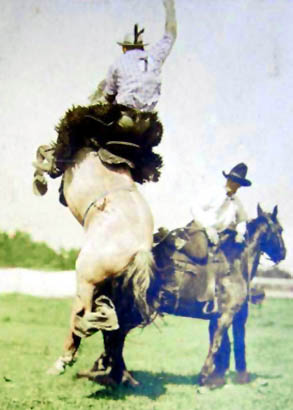 . . . . . .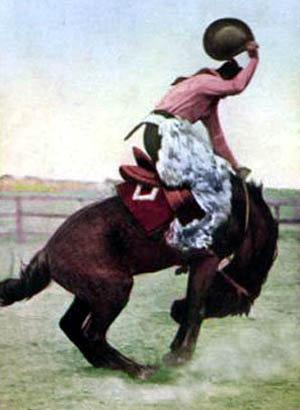
Left, Tex Parker on K.C. Roan, Wyoming State Fair, Douglas, 1918, Photo by Ralph Doubleday.
Right, Everett Cleveland "Curly" McGuckin, Frontier Days, 1912, Photo by Joseph Shimitz.
Curly McGuckin (1884-1953) was C. B. Irwin's brother-in-Law. He participated in the 1912 Pendleton Roundup. In July 1920, Curly moved to Oklahoma.
In March, 1919 Tex wrote another letter to Mr. Waddy indicating that he could be reached at Greybull care of
the Smoke House Pool Room.:
Glad to see that the bunch is keeping the Corral going. Have been here since the State Fair at Douglas, W., last fall and am doing well. Sam Scovill, who once won the
World's championsh;ip in bronk riding at Cheyenne, is living here and sends his best regards to all friends. I am going to put out the best cowboy clown act in the business the coming season.
Have spent a lot of money for wardrobe and a trained mule, and it will be the best that ever hit the road. It has sure been cold up here. Best regards to all the Wild West folks. Mr. Doubleday--I have written you twice to
Cheyenne and received no answer. Why so quiet? I would like to hear from all."
Sam Scovill was the 1905 champion riding Steamboat to a finish, narrowly beating out Hugh Clark. Steamboat tossed the audience favorite, Otto Plaga.
Tex started a career as a Rodeo Clown eventually teaming up with curly Griffith.
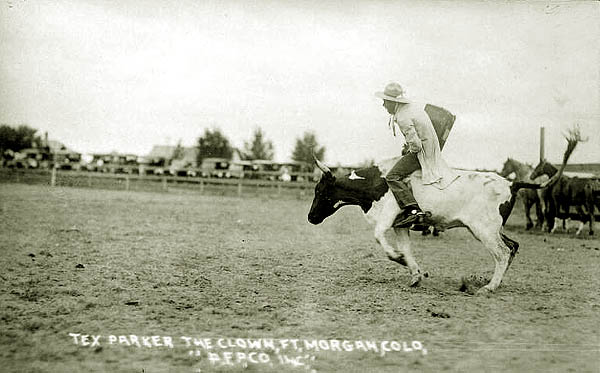
Tex Parker at Fort Morgan.
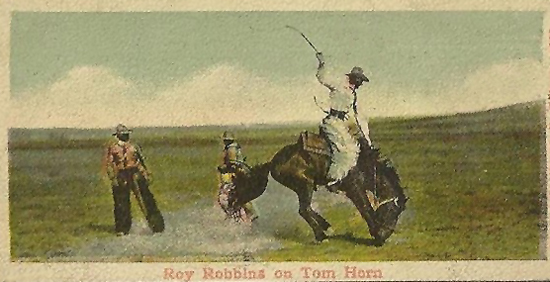
Roy "Skeeter Bill" Robbins at Rawlins.
He was a brother of Walter "Skinny" Robbins, Charles "Doc" Robbins, and of "Wild Horse" Frank Robbins owner of the famed
palomino "Desert Dust."
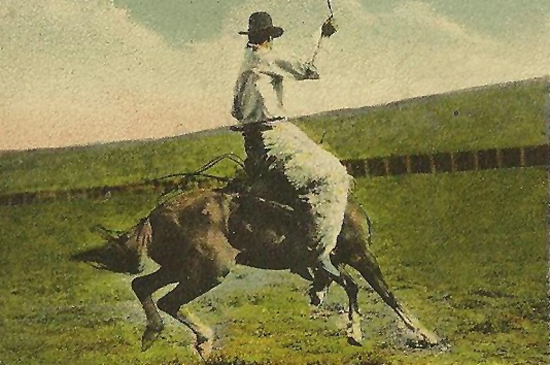
Roy "Walter Robbins on Gin Fiz at Rawlins.
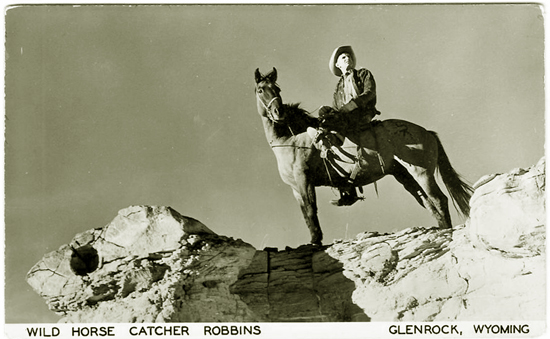
Frank Robbins.
Frank Robbins began catching wild horses in the Red Desert near Rawlins in 1935. Later he pioneered the use of airplanes in wild horse roundups.
Some of the horses, descendents of Spanish mustangs, were
broken and became saddle horses. Others were entered in rodeos and others made their final trip to dog food
factories. In 1945, west of Rawlins Frank caputured Desert Dust who was the leader of his band. In 1946 Desert Dust was featured in the
movie Flight of the Wild Stallions. A passerby shot and killed Desert Dust while he was pastured at Frank's ranch
near Glen Rock.
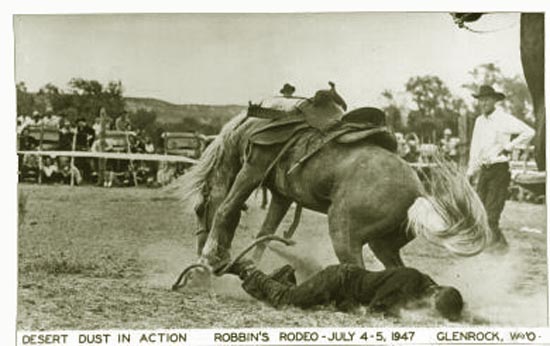
Desert Dust in action, 1947.
The Glen Rock Rodeo was organized and conducted by Frank Robbins.
Skeeter Bill
was a top bronc rider, trick roper and bull dogger. Additionally he organized dances that were held in conjunction with
various rodeos up and down the West Coast. In 1914, he married
Dorothy Morrell 1914 Pendleton champion lady bronc rider of the world.
Just as today, the Mecca for rodeo cowboys is Oklahoma City, in 1924 the center of the Universe for cowboys was the
First International Cowboy Championships at Wembley's newly constructed Empire Stadeum. The championships were held
as a part of the British Empire Exhibition. Many of the participants in Frontier Days including Morrell and Skeeter Bill, Phil Yoder, Mike and Fox Hastings, and Mabel Strickland.
headed across the Atlantic to paticipate in the Wembley Rodeo being staged by Tex Austin and
Charles cochran. But already, storms of controversy were to ovetake what was intended as
the World's greatest Rodeo. On May 21 as he was about to board the S.S. Lapland bound for
Southampton, the New York Post questioned Skeeter about the handling and cruelty to horses.
He responded pointing to horses used on the wharves, "Strike me sky-blue purple paralitic pink. An they call these here rodeos inhhuman!"
Mext page: Skeeter Bill continued, the Wembley Rodeo
|